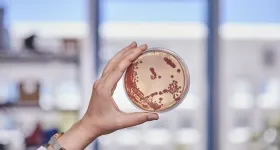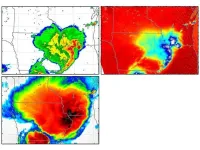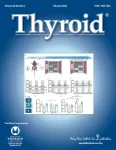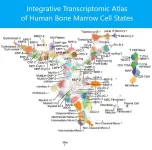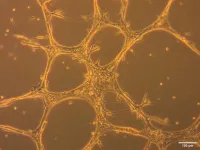(Press-News.org) Many important medicines, such as antibiotics and anticancer drugs, are derived from natural products from Bacteria. The enzyme complexes that produce these active ingredients have a modular design that makes them ideal tools for synthetic biology. By exploring protein evolution, a team led by Helge Bode from the Max Planck Institute for Terrestrial Microbiology in Marburg, Germany, has found new "fusion sites" that enable faster and more targeted drug development.
Industry often follows the assembly line principle: components are systematically assembled into complex products, with different production lines yielding different products. However, not humans are the actual inventors of this principle, but bacteria. Non-ribosomal peptide synthetases (NRPS) are bacterial enzymes that, like production lines, produce an immense variety of natural products. They enable bacteria to survive in a wide variety of natural habitats. Humans have benefited significantly from these enzyme complexes, as they are the origin of many important drugs like antibiotics.
Multitude of enzyme variants generates diversity of natural substances
The research group of Helge Bode at the Max Planck Institute for Terrestrial Microbiology in Marburg is investigating the use of these enzyme systems for the targeted production of drugs in the laboratory. The researchers modify parts of the enzymes and thus the functional properties of the entire enzyme complexes (NRPS engineering) in order to produce products with new properties. However, although this concept has been pursued for several years, it has not yet worked as hoped. "We realized that there is a great opportunity in taking nature as a model. If we understand the natural processes, we will know which areas of the enzyme are best suited for NRPS engineering," explains Kenan Bozhüyük.
Recombination following the natural model
To find out which subunits of the enzyme work particularly well together, the team focused on the question: What are the positions that evolution itself applies to establish or change the new "assembly lines" to create the required active compounds? Together with the group of Georg Hochberg from the Max Planck Institute for Terrestrial Microbiology and Michael Groll (from the Technical University Munich, the team screened for "hotspots" of natural recombination. "We analyzed several tens of thousands of enzymes bioinformatically and then combined the analysis with laboratory experiments to verify the predicted target sites," explain the first authors Leonard Präve and Carsten Kegler.
In fact, the team found a new "fusion point" for the targeted production of functional NRPS hybrids. They were even able to combine NRPS sequences from completely different organisms, such as bacteria and fungi.
The researchers then tested their new knowledge in a medical context: They constructed a new, pharmacologically active peptide. The comprehensive study demonstrates the great potential of bacterial natural products as the basis for new drugs.
The aim is to create customised medicines
"Research in both, synthetic biology and evolutionary biochemistry, has made enormous progress in recent years," said Bode, Director at the Max Planck Institute in Marburg. "The key advantage of our approach is that we are using evolutionary processes that have proven themselves over millions of years. Our evolution-inspired fusion sites are more versatile and have higher success rates.”
The team's concept combines synthetic biology with the high-throughput methods needed to discover biologically active compounds faster and more cost-effectively. In this way, the researchers hope to develop customized biological drugs with improved therapeutic properties - something that is becoming increasingly important in view of the rise in drug resistance and drug intolerance.
END
A new path to drug diversity
Research on protein evolution reveals new starting points for the rapid and targeted development of future drugs
2024-03-21
ELSE PRESS RELEASES FROM THIS DATE:
Satellite data assimilation improves forecasts of severe weather
2024-03-21
UNIVERSITY PARK, Pa. — In 2020, a line of severe thunderstorms unleashed powerful winds that caused billions in damages across the Midwest United States. A technique developed by Penn State scientists that incorporates satellite data could improve forecasts — including where the most powerful winds will occur — for similar severe weather events.
The researchers reported in the journal Geophysical Research Letters that adding microwave data collected by low-Earth-orbiting satellites to existing computer weather forecast models produced more accurate forecasts of surface gusts in a case study of the 2020 Midwest ...
Morality among low-risk differentiated thyroid cancer survivors in the U.S.
2024-03-21
A new study has shown that overall and cause-specific mortality rates in individuals in the U.S. with low-risk differentiated thyroid cancer (DTC) are low. The study is published in the peer-reviewed journal Thyroid®, the official journal of the American Thyroid Association® (ATA®). Click here to read the article now.
Cari Kitahara, PhD, from the National Cancer Institute, National Institutes of Health, and coauthors identified 51,854 individuals diagnosed with first primary DTC at low risk ...
Most detailed atlas to date of human blood stem cells could guide future leukemia care
2024-03-21
Thanks to an unusual application of game theory and machine learning technology, a large team of scientists led by experts at Cincinnati Children’s has published the world’s most detailed “atlas” of the many types of stem cells and early progenitors involved in producing human blood from diverse donors.
The team has identified more than 80 distinct subsets of hematopoietic stem and progenitor cells (HSPCs) – early-stage cells that kick off production of mature red cells, white cells ...
Novel method to measure root depth may lead to more resilient crops
2024-03-21
UNIVERSITY PARK, Pa. — As climate change worsens global drought conditions, hindering crop production, the search for ways to capture and store atmospheric carbon causing the phenomenon has intensified. Penn State researchers have developed a new high-tech tool that could spur changes in how crops withstand drought, acquire nitrogen and store carbon deeper in soil.
In findings published in the January issue of Crop Science, they describe a process in which the depth of plant roots can be accurately estimated by scanning leaves with ...
Scientists develop catalyst designed to make ammonia production more sustainable
2024-03-21
Ammonia is one of the most widely produced chemicals in the world, and is used in a great many manufacturing and service industries. The conventional production technology is the Haber-Bosch process, which combines nitrogen gas (N2) and hydrogen gas (H2) in a reactor in the presence of a catalyst. This process requires high levels of temperature and pressure, resulting in substantial power consumption. Indeed, ammonia production is estimated to consume 1%-2% of the world’s electricity and to account for about 3% of global carbon emissions.
In pursuit of more sustainable alternatives, researchers affiliated with the Center for Development of Functional Materials (CDMF) ...
Forest, stream habitats keep energy exchanges in balance, global team finds
2024-03-21
UNIVERSITY PARK, Pa. — Forests and streams are separate but linked ecosystems, existing side by side, with energy and nutrients crossing their porous borders and flowing back and forth between them. For example, leaves fall from trees, enter streams, decay and feed aquatic insects. Those insects emerge from the waters and are eaten by birds and bats. An international team led by Penn State researchers has now found that these ecosystems appear to keep the energy exchanges in balance — a finding that the scientists called surprising.
Scientists ...
Product that kills agricultural pests also deadly to native Pacific Northwest snail
2024-03-21
CORVALLIS, Ore. – A product used to control pest slugs on farms in multiple countries is deadly to least one type of native woodland snail endemic to the Pacific Northwest, according to scientists who say more study is needed before the product gains approval in the United States.
Dee Denver of the Oregon State University College of Science led a 10-week laboratory project that showed the effect of a biotool marketed as Nemaslug on the Pacific sideband snail. The study was published today in PLOS One.
Nemaslug is based on the organism Phasmarhabditis hermaphrodita, a species of tiny, parasitic worm known as a nematode.
The ...
Two keys needed to crack three locks for better engineered blood vessels
2024-03-21
UNIVERSITY PARK, Pa. — Blood vessels engineered from stem cells could help solve several research and clinical problems, from potentially providing a more comprehensive platform to screen if drug candidates can cross from the blood stream into the brain to developing lab-grown vascular tissue to support heart transplants, according to Penn State researchers. Led by Xiaojun “Lance” Lian, associate professor of biomedical engineering and of biology, the team discovered the specific molecular signals that can efficiently mature nascent stem cells into the endothelial cells that comprise the vessels and regulate exchanges to and ...
UTEP faculty launch research lab to support human performance
2024-03-21
EL PASO, Texas (Mar. 21, 2024) - Professors at The University of Texas at El Paso have launched a new industrial engineering lab focused on supporting human performance and behavior in various application areas. Projects include supportive exoskeletons for high-strain occupations and virtual reality that simulates high-stress environments.
The facility, known as the Physical, Information and Cognitive Human Factors Engineering (PIC-HFE) Research Lab, was established with the help of a $350,000 STAR grant from the State of Texas.
The lab is led by Priyadarshini Pennathur, Ph.D., and Arunkumar ...
Improving & maintaining heart health after pregnancy may reduce the risk of future CVD
2024-03-21
Research Highlights:
An analysis of health records for almost 110,000 women in the U.K. found that women with poor cardiovascular health after pregnancy or who experienced adverse pregnancy outcomes, including high blood pressure, gestational diabetes and/or pre-term birth, had a significantly higher long-term risk of developing cardiovascular disease.
Among women with adverse pregnancy outcomes, those who maintained better cardiovascular health after pregnancy had cardiovascular disease risk similar to women who had no history of pregnancy complications.
Embargoed until 1:30 p.m. CT/2:30 ...
LAST 30 PRESS RELEASES:
Making lighter work of calculating fluid and heat flow
Normalizing blood sugar can halve heart attack risk
Lowering blood sugar cuts heart attack risk in people with prediabetes
Study links genetic variants to risk of blinding eye disease in premature infants
Non-opioid ‘pain sponge’ therapy halts cartilage degeneration and relieves chronic pain
AI can pick up cultural values by mimicking how kids learn
China’s ecological redlines offer fast track to 30 x 30 global conservation goal
Invisible indoor threats: emerging household contaminants and their growing risks to human health
Adding antibody treatment to chemo boosts outcomes for children with rare cancer
Germline pathogenic variants among women without a history of breast cancer
Tanning beds triple melanoma risk, potentially causing broad DNA damage
Unique bond identified as key to viral infection speed
Indoor tanning makes youthful skin much older on a genetic level
Mouse model sheds new light on the causes and potential solutions to human GI problems linked to muscular dystrophy
The Journal of Nuclear Medicine ahead-of-print tip sheet: December 12, 2025
Smarter tools for peering into the microscopic world
Applications open for funding to conduct research in the Kinsey Institute archives
Global measure underestimates the severity of food insecurity
Child survivors of critical illness are missing out on timely follow up care
Risk-based vs annual breast cancer screening / the WISDOM randomized clinical trial
University of Toronto launches Electric Vehicle Innovation Ontario to accelerate advanced EV technologies and build Canada’s innovation advantage
Early relapse predicts poor outcomes in aggressive blood cancer
American College of Lifestyle Medicine applauds two CMS models aligned with lifestyle medicine practice and reimbursement
Clinical trial finds cannabis use not a barrier to quitting nicotine vaping
Supplemental nutrition assistance program policies and food insecurity
Switching immune cells to “night mode” could limit damage after a heart attack, study suggests
URI-based Global RIghts Project report spotlights continued troubling trends in worldwide inhumane treatment
Neutrophils are less aggressive at night, explaining why nighttime heart attacks cause less damage than daytime events
Menopausal hormone therapy may not pose breast cancer risk for women with BRCA mutations
Mobile health tool may improve quality of life for adolescent and young adult breast cancer survivors
[Press-News.org] A new path to drug diversityResearch on protein evolution reveals new starting points for the rapid and targeted development of future drugs
